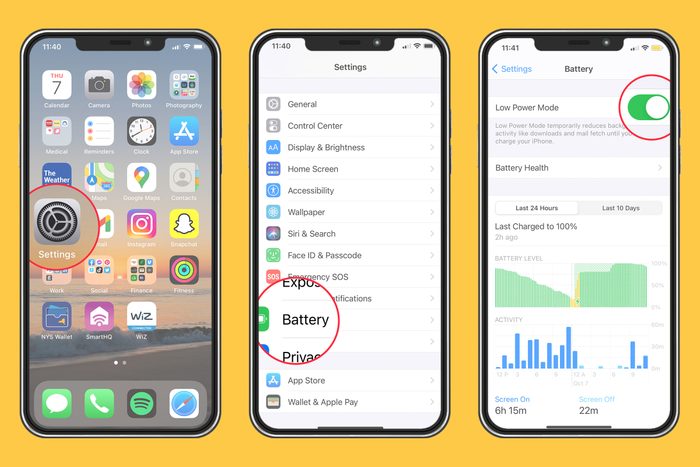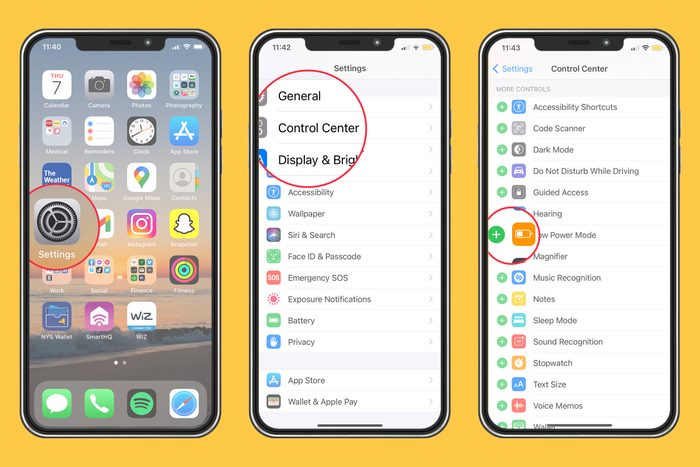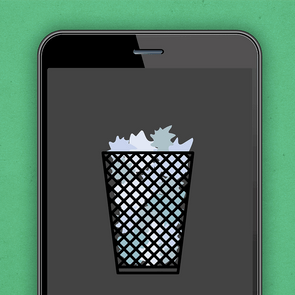Odds are, the dreaded “Low Power Mode” notification sends you searching for the nearest power outlet. But you might be surprised by how often this feature can come in handy, and not just when your phone is about to die. So, what does this do, exactly? We asked the experts to give us the lowdown—from why and when you should use it to how to turn it on and off.
What does Low Power Mode do?
Low Power Mode is a feature that reduces the amount of power your iPhone uses, which extends the life of its battery. You’ll know the feature is activated when the battery icon at the top right-hand corner of the screen is yellow. Though iPhones have offered it for several years, Android users can also access a similar feature. “Some variant of the setting exists on all modern smartphones, and while the name may be slightly different, it typically works the same on all of them,” says Stan Schroeder, a tech journalist and senior editor at Mashable. (Check out the 11 phone battery myths you really have to stop believing.)
How does it work?
When enabled, the feature turns off “some power-hungry features that aren’t completely essential,” says Chris Hoffman, editor-in-chief of How-To Geek. Your iPhone stops using 5G cellular service, pauses uploading photos to iCloud Photos, disables apps from refreshing in the background, and takes other power-saving actions. It automatically turns on when your phone’s battery runs low, or you can manually activate it at any time.
What are the benefits of Low Power Mode?
Aside from reducing the amount of power your iPhone uses and extending battery life, what does it do? Turns out, putting your phone in Low Power Mode can also lower data usage, according to Schroeder. Certain apps use data to update their content, even when you are not using them. By activating it, you can prevent those apps from refreshing in the background—a little-known tech trick that can help you use less data and lower your phone bill. (Here’s why you should never charge your phone in rental cars.)
Is it bad for your iPhone?
While using this feature won’t hurt your iPhone, “you might miss some of the functionality that is turned off while in Low Power Mode,” Schroeder says. For example, your iPhone would almost never upload new photos to the iCloud Photos or connect to fast 5G signals, according to Hoffman. He suggests permanently disabling 5G, tweaking app background refresh settings, or using an external battery to make your phone’s battery last longer, instead.
Can you keep your phone in Low Power Mode all the time?
You can keep your iPhone in Low Power Mode all the time, but experts wouldn’t recommend it. First, it’s inconvenient to keep certain features like 5G and iCloud Photos turned off, according to Hoffman. “It’s also impossible to ‘permanently’ put an iPhone in Low Power Mode,” he says. “When your iPhone charges to 80 percent battery, your iPhone will automatically take itself out of Low Power Mode.” That said, both Hoffman and Schroeder agree that manually activating it can be helpful for times when your iPhone’s battery struggles to last the entire day. (Discover the 10 ways you’re shortening the life of your phone.)

How to turn it on
To turn on Low Power Mode, follow these steps. The battery icon at the top right-hand corner of the phone’s screen will turn yellow when the feature is enabled.
- Go to Settings.
- Tap Battery > Low Power Mode.
- Toggle the switch to the “on” position.
Once you no longer want your iPhone in it, go back to the same spot and toggle the switch to “off.”

How to add it to your iPhone’s Control Center
Low Power Mode can make your phone’s battery last longer, so it is “a feature you may want to use quite often,” Schroeder says. Make it easier to access Low Power Mode in the future by adding it to your iPhone’s Control Center.
- Go to Settings.
- Tap Control Center.
- Scroll down to the More Controls menu.
- Tap on the green “+” icon next to Low Power Mode.
Next, check out 40 iPhone tricks that will make things so much easier.
Loving Life in Moosonee
Born in Moose Factory Island, located about 12 miles inland from the James Bay coastline in northern Ontario, I spent my early childhood years in nearby Moose River Crossing. Our family returned to Moose Factory later, so my siblings and I could continue our education, as the local school had been closed down.
Moose River Crossing is situated along the only railroad track in Canada that reaches all the way up to the northern community of Moosonee, Ont., which later became—and still is—my true hometown.
While my siblings and I were growing up, I always sensed something was missing in my life, something fundamental to my very identity, to who I was and where I came from. Over the years, I began to learn more about my Native culture, the history and our way of life. Then, in 2009, I met a man who later became my husband. Being an ambassador of the land and a hunter, my husband taught me how to hunt, fish, set nets, snare rabbits, make a fire in the rain, read the weather and drive a boat. Even after having lived in Moosonee for 26 years, I had never experienced and learned so much on the land and the mighty Moose River, where the sunsets are breathtakingly beautiful, as I did in the relatively short time I’ve known my husband.
I am so thankful and proud to have been give the opportunity to lead this kind of lifestyle, which someday will be passed on to my grandchildren.
Today, I continue to trace my roots and try to live my life according to them. I have also been back to Moose River Crossing, after being away for many years. My older sister and only brother, both hunters, along with a few nephews and nieces, continue to carry on the traditions of our ancestors in Moose River Crossing.
Every year, our family gathers for a spring hunt, mainly geese and ducks. In summertime, we fish for sturgeon and, in the fall, we head out moose hunting. In addition to adding to our provisions for the year, these excursions are where our family stories and recollections are shared the most. And there are plenty of stories to go around, all of which are close to my heart and a big part of who I am today.
Next, check out the eye-opening artwork of Métis artist Jim Logan.





